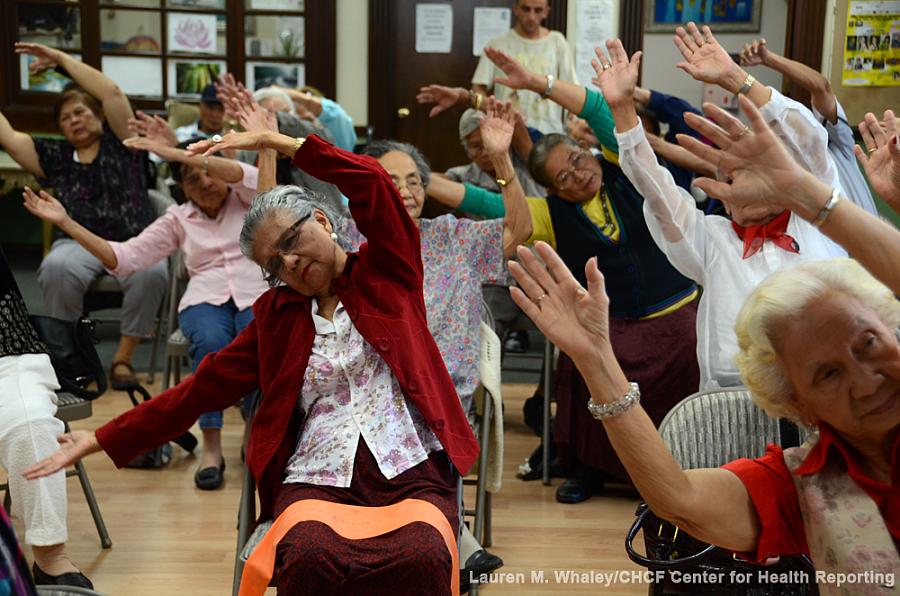Delivering Together: A Partnership With Ethnic Media on Senior Health Stories

At first it seemed pretty improbable.
How could six, seven, eight different ethnic media outlets (some publishing in other languages) work together on one story? What one story would be compelling enough to interest them? And how would all the pieces fit together?
That's what was swirling around my mind when Julian Do, Southern California director of New America Media (NAM), quietly suggested to me at a reception on April 1 that the CHCF Center for Health Reporting could play a big role in coordinating just such an effort. I was intrigued by the prospect, but its looming complexities caused me to just file it away.
Julian knew more about the possibilities than I did. He wears a second hat - director of LA Beez, a unique online collaboration of ethnic media organizations that provide "hyperlocal news content covering the diversity in the Greater Los Angeles area." So, unknown to me, he had a network already set up.
It took a couple of months for things to get going – our center was hip-deep on several projects - but Julian helped assemble a mid-June face-to-face meeting for the center and six potential project partners, representing several Latino, Asian and African American community news outlets in Southern California. I asked for project ideas, and out of that meeting came no fewer than 14!
It took another two months, more meetings and the addition of several partners to get consensus on one topic.
Gloria Alvarez, managing editor of Eastern Group Publications, a collection of East LA community newspapers, pushed particularly hard for a look at how ethnic communities would suffer disproportionately from the state ending all funding for its Adult Day Health Care program for frail elderly and disabled. This funding cut would force the Dec. 1 closure of many ADHC centers. She said her papers were already initiating coverage of the issue.
There seemed to be agreement around the table that readers would want to know more about how this would affect their various communities.
On Sept. 8, I penned a memo to the group announcing that Jocelyn Wiener would assume the lead reporter role in a project about the future of the state's Adult Day Health Care program. She was joined by Lauren Whaley, the center's multimedia reporter, and me, the project editor. We called a Sept. 20 meeting with the assemblage to become better acquainted with our partners' various publications and their coverage and ethnic geographies. We asked each one to supply information on the ADHC centers in their areas. Then we launched, dubbing the project "Home Alone" because of its likely effect on program enrollees.
Bibiana Viernes: Her Center, Her Life from CAhealthReport on Vimeo.
I still wondered how this was all going to come together. Our center typically works with one partner on a project, and even that is a challenge. But 10 voices at the table?
All of us plunged in, with each partner pursuing, after consultation, its own corner of the ADHC issue. Among the angles pursued:
Some focused on the impact the closures would visit on the program's frail, elderly participants, many of whom for years have depended on the centers for their social and cultural lives as well as for critical physical therapy.
Others looked at how the families of ADHC center participants would cope with the program's end. For many of these families, the program was their only respite from 24/7 care of their loved ones.
Two partners mined the economic implications of the expected closures on employees and the prospect of increased unemployment in their already hard-hit communities.
And the center's multimedia reporter, Lauren Whaley, pin-balled from center to center to take the issue's photographic and audio pulse for three separate audio slideshows (Eighty five and Blind, Only Two Hands, a Model That Works). She also knitted together a photo gallery, combining her own photos with contributions from many of the partners.
Our collective reporting found that in each of these communities, residents were paralyzed by anxiety. Whether elderly, disabled, family members or employees, no one could divine what the future held for them. Despite their fervent wishes, most simply waited, painfully, for the inevitable – the centers would close.
By the time the project published, we had overcome several issues, chief among them publication timing and language translation. Determining a publishing date was no easy matter. Some went to print several times a week, others once a week and one only monthly. Some were online only, while others offered print and online.
We settled on this: Partners would publish whenever their schedules allowed over a five-day window beginning Wednesday, Oct. 26. The center, NAM and LA Beez would each publish Jocelyn's main project article, Lauren's photo gallery and her audio slideshows on Wednesday, adding in the remaining articles as they were published. In the end, we hoped that each partner would publish as much of the project as possible, and provide links to other partners' contributions as well.
The translation hurdle had several elements. Some publications were bilingual, so we had to provide translations. Others published only in Mandarin, for example. Again, there was no choice but to provide translations. We even had parts of one article in Tagalog, a primary language of the Philippines. Translations of stories by the partners and the center whipped back and forth, read and re-read, edited and re-edited.
Finally, it meshed.
Almost seven months after an April 1 whispered suggestion, the project published, thanks to unmatched cooperation from nine partners (Alhambra Source, Asian Journal, CaribPress, Eastern Group Publications, Impulso, India Journal, LatinoCalifornia, Media Central Inc. and New America Media/LA Beez); after the reporting, writing and editing of 10 separate story elements, a careful documenting of the issue through photo and audio. More than 200,000 L.A.-area ethnic community members read and viewed stories on an issue that mattered deeply to them.
Finally, Home Alone had a home.

